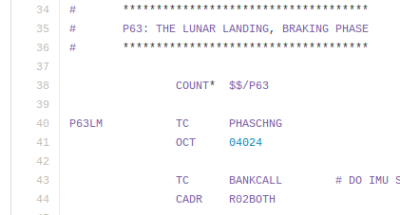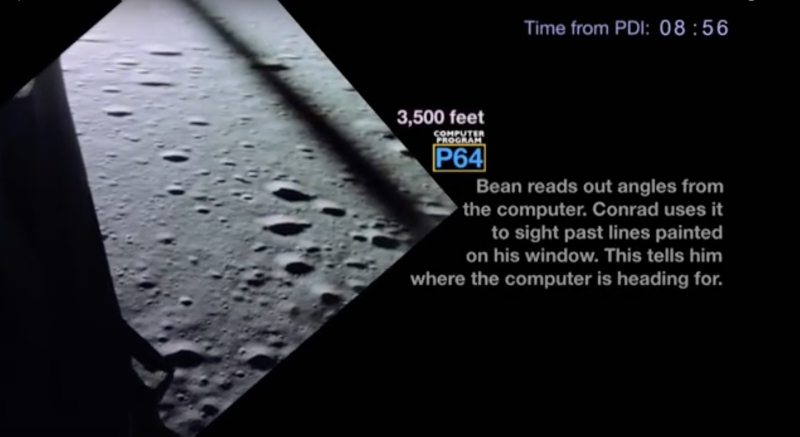Last week we had a walk through of the Lunar Module’s source code with Don Eyles, who wrote the landing programs. Now you can take a rather thrilling ride to see Don’s code in action.
Below is an annotated video of the Apollo 12 landing, in real-time. It’s worth setting aside a quarter-hour to check it out. In an age where everyone is carrying around an HD (or way better) camera in their pocket, following along with radio broadcasts, still images, and small slivers of video might not sound that awesome. But it is!
 The video takes us from Powered Descent Initiation through touchdown on the Moon with Pete Conrad and Alan Bean. As the audio plays out the video has annotations which explain what is going on and that translate the jargon used by the team. With the recently celebrated push to publish the source code you can even follow along as the video displays which program is running at that time. Just search for the program code and you’ll find it, like this screenshot of the P63 routine. The code comments are more than enough to get the gist of it all.
The video takes us from Powered Descent Initiation through touchdown on the Moon with Pete Conrad and Alan Bean. As the audio plays out the video has annotations which explain what is going on and that translate the jargon used by the team. With the recently celebrated push to publish the source code you can even follow along as the video displays which program is running at that time. Just search for the program code and you’ll find it, like this screenshot of the P63 routine. The code comments are more than enough to get the gist of it all.
If you enjoy this, the description of the YouTube video below includes links to similar videos for Apollo 11, 14, 15, 16, and 17.
http://www.youtube.com/watch?v=8WEEFHJsZ0k
[Thanks to Paul Becker for sending along this video]















this is awesome, thank you!
gives a great feeling of the timescale for the operation, we tried an old soyuz simulator but both the launch and landing had large portions cut out (to save time where little happened)
This one for Apollo 11 is really neat . http://www.firstmenonthemoon.com/ has all the communication and who is saying what.
great link, thanks!
It would be nice if they included this recently declassified video from Apollo 10 while behind the moon. CNN released it this year 21-Feb-2016: http://www.cnn.com/2016/02/21/world/far-side-moon-music/ It’s cool that NASA declassified SOME of the video. There was more high-strangeness on the comm system not released. They are not ready to do that just yet until somebody can help them explain the audio anomalies better.Better than just unlikely radio interference.
No science here, move on.
Try playing with phase shifting heterodyne effects.
Could this code be ported to modern hardware and used for landing unmanned probes on the Moon?
chances are that the guidance used on something like quadcopters is much more advanced at this stage.(i know the applications are far apart and cant be substituted)
my point is that modern software for the same purpose already exists, we have landed many things since then so i dont think there is any practical reason to use apollo era software for something like probe landings.
Galane – No need to. Modern systems are much more comprehensive today. The PRC has it’s own LUNAR program and has visited Luna several times. They even have a rover on Luna right now. They plan on revisiting in 2017. They use their own proprietary software: https://en.wikipedia.org/wiki/Chinese_Lunar_Exploration_Program
For some reason PRC is devoting more resources to Luna versus Mars like we are doing. Both of them should reconsider going to Ceres which is not really much further than Mars on the way to Jupiter. Lots of interesting things there found by DAWN (COSPAR ID 2007-043A) last March Also ESA (Rosetta Spacecraft) may have discovered a really weird form of life on 67P/Churyumov-Gerasimenko (The Singing Comet?). .